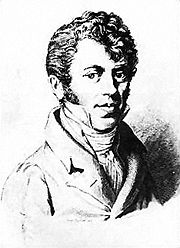
Sigismund von Neukomm
Encyclopedia

Salzburg
-Population development:In 1935, the population significantly increased when Salzburg absorbed adjacent municipalities. After World War II, numerous refugees found a new home in the city. New residential space was created for American soldiers of the postwar Occupation, and could be used for...
, 10 July 1778 - Paris
Paris
Paris is the capital and largest city in France, situated on the river Seine, in northern France, at the heart of the Île-de-France region...
, 3 April 1858) was an Austria
Austria
Austria , officially the Republic of Austria , is a landlocked country of roughly 8.4 million people in Central Europe. It is bordered by the Czech Republic and Germany to the north, Slovakia and Hungary to the east, Slovenia and Italy to the south, and Switzerland and Liechtenstein to the...
n composer and pianist.
Neukomm first studied with the organist Weissauer and later studied theory under Michael Haydn
Michael Haydn
Johann Michael Haydn was an Austrian composer of the classical period, the younger brother of Joseph Haydn.-Life:...
, though his studies at Salzburg University were in philosophy and mathematics. He became honorary organist at the Salzburg University church in 1792, and was appointed chorus-master at the Salzburg court theater in 1796. Neukomm was kapellmeister
Kapellmeister
Kapellmeister is a German word designating a person in charge of music-making. The word is a compound, consisting of the roots Kapelle and Meister . The words Kapelle and Meister derive from the Latin: capella and magister...
at St. Petersburg's German theatre from 1804 to 1809, and in the 1810s he spent time in Brazil
Brazil
Brazil , officially the Federative Republic of Brazil , is the largest country in South America. It is the world's fifth largest country, both by geographical area and by population with over 192 million people...
, South America
South America
South America is a continent situated in the Western Hemisphere, mostly in the Southern Hemisphere, with a relatively small portion in the Northern Hemisphere. The continent is also considered a subcontinent of the Americas. It is bordered on the west by the Pacific Ocean and on the north and east...
, where he popularized the works of Joseph Haydn
Joseph Haydn
Franz Joseph Haydn , known as Joseph Haydn , was an Austrian composer, one of the most prolific and prominent composers of the Classical period. He is often called the "Father of the Symphony" and "Father of the String Quartet" because of his important contributions to these forms...
and Wolfgang Mozart. He worked at D. João VI's court in Rio de Janeiro
Rio de Janeiro
Rio de Janeiro , commonly referred to simply as Rio, is the capital city of the State of Rio de Janeiro, the second largest city of Brazil, and the third largest metropolitan area and agglomeration in South America, boasting approximately 6.3 million people within the city proper, making it the 6th...
.
Neukomm's compositional output is large. With the older composer's approval he made arrangements of Haydn's works, including the oratorio
Oratorio
An oratorio is a large musical composition including an orchestra, a choir, and soloists. Like an opera, an oratorio includes the use of a choir, soloists, an ensemble, various distinguishable characters, and arias...
s The Seasons
The Seasons (Haydn)
The Seasons is an oratorio by Joseph Haydn .-Composition, premiere, and reception:Haydn was led to write The Seasons by the great success of his previous oratorio The Creation , which had become very popular and was in the course of being performed all over Europe...
and The Creation. He wrote a clarinet quintet
Quintet
A quintet is a group containing five members.It is commonly associated with musical groups, such as a string quintet, or a group of five singers, but can be applied to any situation where five similar or related objects are considered a single unit....
, several organ voluntaries
Voluntary (music)
In music a voluntary is a piece of music, usually for organ, which is played as part of a church service. In English-speaking countries, the music played before and after the service is often called a 'voluntary', whether or not it is titled so....
, ten opera
Opera
Opera is an art form in which singers and musicians perform a dramatic work combining text and musical score, usually in a theatrical setting. Opera incorporates many of the elements of spoken theatre, such as acting, scenery, and costumes and sometimes includes dance...
s, incidental music
Incidental music
Incidental music is music in a play, television program, radio program, video game, film or some other form not primarily musical. The term is less frequently applied to film music, with such music being referred to instead as the "film score" or "soundtrack"....
for four plays, 48 mass
Mass (music)
The Mass, a form of sacred musical composition, is a choral composition that sets the invariable portions of the Eucharistic liturgy to music...
es, 8 oratorios, and a large body of smaller works including vocal pieces, works for piano solo, and about 200 songs.
In 1814 Neukomm was responsible for erecting a tombstone to the memory of Haydn over his first grave in the Hundsturm
Hundsturm
Hundsturm was an independent municipality of Austria until 1850 and is today a suburb of Vienna, in the 5th District of Vienna, Margareten....
cemetery in Vienna. The inscription included a puzzle canon composed by Neukomm himself. He had previously been one of Haydn's pupils, and was also in regular contact with the composer in the last months of his life.
Source
- Vincenzo Cernicchiaro. Storia della musica nel Brasile. Milano, Fratelli Riccioni, 1926.
- Don Randel. The Harvard Biographical Dictionary of Music. Harvard, 1996, p. 633.

